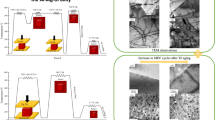Abstract
The present paper addresses the investigation of the evolution of the residual stresses (RS) under unidirectional cycling loading in cold formed parts. Through a basic three point bending process, the bare phenomena of relaxation were studied by excluding the disturbance of external factors, like friction or temperature gradients. Initially, samples of high strength fine grained steel S960QL (1.8933) with different geometries were manufactured, followed by a stress relief heat treatment. The samples were then bended with attentive process control to obtain a homogeneous stress state. X-Ray diffractometry (XRD) was employed for the experimental measurement of the axial residual stresses along a path in the center line of the specimens. The RS were also predicted through a finite element (FE) model with ABAQUS© using non-linear kinematic hardening. The bended samples were then subjected to further cyclic loading in the bending direction with two different amplitudes, i.e. complete elastic and partially plastic regime. The relaxation of the residual stresses was stepwise analyzed through X-Ray measurements and FE simulations. It was observed, that bending can be an efficient way to study the residual stresses stability during cyclic loading, as it allows the simultaneous examination of different loading situations.













Similar content being viewed by others
References
Withers PJ, Bhadeshia HKDH (2001) Residual stress. part 2—nature and origins. Mater Sci Technol 17:366–375. https://doi.org/10.1179/026708301101510087
Boniardi M, Tagliabue C (2016) Venturini. Origine delle tensioni residue: deformazioni plastiche e lavorazioni meccaniche. La metallurgia italiana
Macherauch E (1979) Neuere untersuchungen zur ausbildung und auswirkung von eigenspannungen in metallischen werkstoffen. Mat-wiss u Werkstofftech 10:97–111. https://doi.org/10.1002/mawe.19790100309
Cao W, Khadhraoui M, Brenier B, Guédou JY, Castex L (1994) Thermomechanical relaxation of residual stress in shot peened nickel base superalloy. Mater Sci Technol 5:947–954
Cai z, Huang X (2011) Residual stress reduction by combined treatment of pulsed magnetic field and pulsed current. Mater Sci Eng A 528:6287–6292. https://doi.org/10.1016/j.msea.2011.04.078
Alshits VI, Darinskaya EV, Koldaeva MV, Petrzhik EA (2003) Magnetoplastic effect: Basic properties and physical mechanisms. Crystallogr Rep 48:768–795. https://doi.org/10.1134/1.1612598
McClung RC (2007) A literature survey on the stability and significance of residual stresses during fatigue. Fat Frac Eng Mat Struct 30:173–205. https://doi.org/10.1111/j.1460-2695.2007.01102.x
Xie X-f, Jiang W, Luo Y, Xu S, Gong J-M, Tu S-T (2017) A model to predict the relaxation of weld residual stress by cyclic load: Experimental and finite element modeling. Int J Fatigue 95:293–301. https://doi.org/10.1016/j.ijfatigue.2016.11.011
Holzapfel H, Schulze V, Voehringer O, Macherauch E (1996) Relaxation behaviour of shot peening induced residual stresses in AISI 4140 due to quasistatic uniaxial loading at elevated temperatures. In: Proceedings. 6th International Conference on Shot Peening, ICSP 6, San Francisco. pp 385–96
Holzapfel H, Schulze V, Vöhringer O, Macherauch E (1998) Residual stress relaxation in an AISI 4140 steel due to quasistatic and cyclic loading at higher temperatures. Mater Sci Eng: A 248:9–18. https://doi.org/10.1016/S0921-5093(98)00522-X
Bergström J, Ericsson T (1986) Relaxation of shot peening induced compressive stress during fatigue of notched steel samples. Surface Eng 6:115–20
Morrow JSGM (1959) Cycle-dependent stress relaxation. In: Symposium on basic mechanisms of fatigue. 99 83–109
Pattinson EJ, Dugdale DS (1962) Fading of residual stresses due to repeated loading. Metallurgia 56:228–230
Kucharczyk P, Madia M, Zerbst U, Schork B, Gerwien P, Münstermann S (2018) Fracture-mechanics based prediction of the fatigue strength of weldments. Eng Fract Mech 5:79–102
Capello E (2005) Residual stresses in turning. J Mater Process Technol 160:221–228. https://doi.org/10.1016/j.jmatprotec.2004.06.012
Klein M, Eifler D (2010) Influences of the process chain on the fatigue behavior of samples with tension screw geometry. Adv Eng Mater https://doi.org/10.1002/adem.200900351
Chaboche JL (2008) A review of some plasticity constitutive therories. Int J Plast 24:1642–1693. https://doi.org/10.1016/j.ijplas.2008.03.009
Reimers W (1999) Analysis of residual stress states using diffraction methods. Acta Phisica Polonica 5:229–238
Schajer GS (2010) Relaxation Methods for Measuring Residual Stresses: Techniques and Opportunities. Exp Mech 50:1117–1127. https://doi.org/10.1007/s11340-010-9386-7
Kudryavtsev YF (2008) Residual Stress. In: Sharpe WN (ed) Springer Handbook of Experimental Solid Mechanics. Springer US, Boston, pp 371–388. https://doi.org/10.1007/978-0-387-30877-7_15
Acknowledgements
Funded by the Deutsche Forschungsgemeinschaft (DFG, German Research Foundation)—OE 558/16-1, GR1818/63-1.
Author information
Authors and Affiliations
Corresponding author
Rights and permissions
About this article
Cite this article
Franceschi, A., Kaffenberger, M., Schork, B. et al. Observations on the stability of the residual stresses after cold forming and unidirectional loading. Prod. Eng. Res. Devel. 13, 157–167 (2019). https://doi.org/10.1007/s11740-018-00871-2
Received:
Accepted:
Published:
Issue Date:
DOI: https://doi.org/10.1007/s11740-018-00871-2




